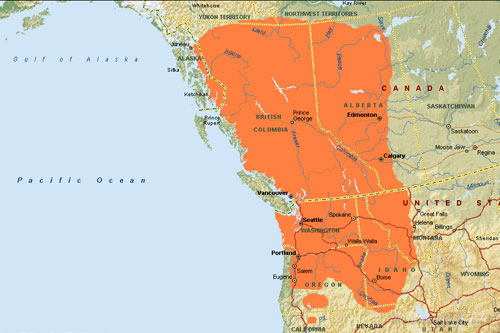Bull Trout:
Salvelinus confluentus, or more commonly known as the bull
trout, is an aquatic animal part of the Salmonidae family and is native to
North American areas like Washington, Oregon, Idaho, Nevada, Montana and Western Canada.
They are commonly found in high mountainous areas where there are glaciers and
snowfields present. While growing up, bull trout feed on zooplankton but once
fully grown, they feast on other fish. In areas like coastal Washington, they
are known to feed heavily off of Salmon eggs. Resident bull trout can grow up
to 10 inches long but migratory bull fish can reach sizes of up to 35 inches
and 32 pounds. Unlike the other fish in the Salmonidae family, bull trout need
specifically cold waters to survive so they tend to stay in waters below 62
degrees (F).
 |
| The geographical range for bull trout in North America: Washington, Oregon, Idaho, Nevada, Montana & Western Canada |
Bull trout are known to have more specific habitat
requirements thank other fish in the Salmonidae family, including needing the
four C’s: cold, clean, complex and connected habitats. The need a cold and
clean environment that is suitable for reproduction and rearing. By complex,
they need streams with riffles, undercut banks and deep pools. Lastly, bull
trout need to have connected habitats between rivers, lakes and oceans so that
they can attend to annual spawning and feeding migration.
Their population got so low that, in 1999, bull trout was
listed, “as threatened throughout their range in the coterminous United States”
(FWS) under the Endangered Species Act. One of the main reasons why bull trout
has become listed as an endangered species is because of habitat degradation
and fragmentation. Many migratory corridors have become blocked and the poor
water quality has made it difficult for fish to reproduce. The introduction of
non-native species, like brown, lake and brook trout have caused bull trout
populations to decline. Many of the remaining populations are small, isolated
and prone to extinction. Another major contributing factor to bull trout
extinction is climate change. Because bull trout need cold water to thrive, warm
spots throughout the waters are causing the populations to become even more
isolated from one another. Climate change is also interfering with other
“stressors, such as habitat loss and fragmentation, invasions of non-native
fish, disease and other threats” (FWS).
As listed on the recovery plan for bull trout, the ESA plans to take the following actions to help the bull trout populations survive:
- Conserve bull trout so that they are geographically widespread across representative habitats and demographically stable in six recovery units;
- Effectively manage and ameliorate the primary threats in each of six recovery units at the core area scale such that bull trout are not likely to become endangered in the foreseeable future;
- Build upon the numerous and ongoing conservation actions implemented on behalf of bull trout since their listing in 1999, and improve our understanding of how various threat factors potentially affect the species;
- Use that information to work cooperatively with our partners to design, fund, prioritize, and implement effective conservation actions in those areas that offer the greatest long-term benefit to sustain bull trout and where recovery can be achieved;
- Apply adaptive management principles to implementing the bull trout recovery program to incorporate new information.
If you would like to personally take action in helping save the bull trout populations, you can take the time and write a letter to your local senator. In the letter you can include points on why the bull trout needs to be conserved. Various national forests, like the Boise National Forest and the Sawtooth National Forest, use the bull trout as a management indicator species. Additionally, bull trout require cold water and low amounts of slit, which road building and logging negatively impact. Lastly, bull trout need to migrate throughout river systems but sometimes they run into dams, which prevent them from passing through. By writing to your local government representative and including a concrete argument, you can help bull trout become delisted from the Endangered Species Act.
Work Cited:
http://www.fws.gov/pacific/bulltrout/
http://nrmsc.usgs.gov/files/norock/products/LakeTrout_03_Info08.pdf
http://www.fws.gov/pacific/news/1997/btfacts.htm
http://www.itis.gov/servlet/SingleRpt/SingleRpt?search_topic=TSN&search_value=162004
Work Cited:
http://www.fws.gov/pacific/bulltrout/
http://nrmsc.usgs.gov/files/norock/products/LakeTrout_03_Info08.pdf
http://www.fws.gov/pacific/news/1997/btfacts.htm
http://www.itis.gov/servlet/SingleRpt/SingleRpt?search_topic=TSN&search_value=162004
_Creek_BC.jpg)
This is a very interesting blog about Bull Trout! I am surprised by how big they can get! It is interesting that they are the only fish in their family to need cold waters to survive. I also thought it was interesting that warming water temperatures are causing the populations to become more isolated. I hope they are able to be recovered! #BIO227Fall2015 -Rayann Metteer
ReplyDelete